ВУЗ: Казахская Национальная Академия Искусств им. Т. Жургенова
Категория: Книга
Дисциплина: Не указана
Добавлен: 03.02.2019
Просмотров: 17287
Скачиваний: 51
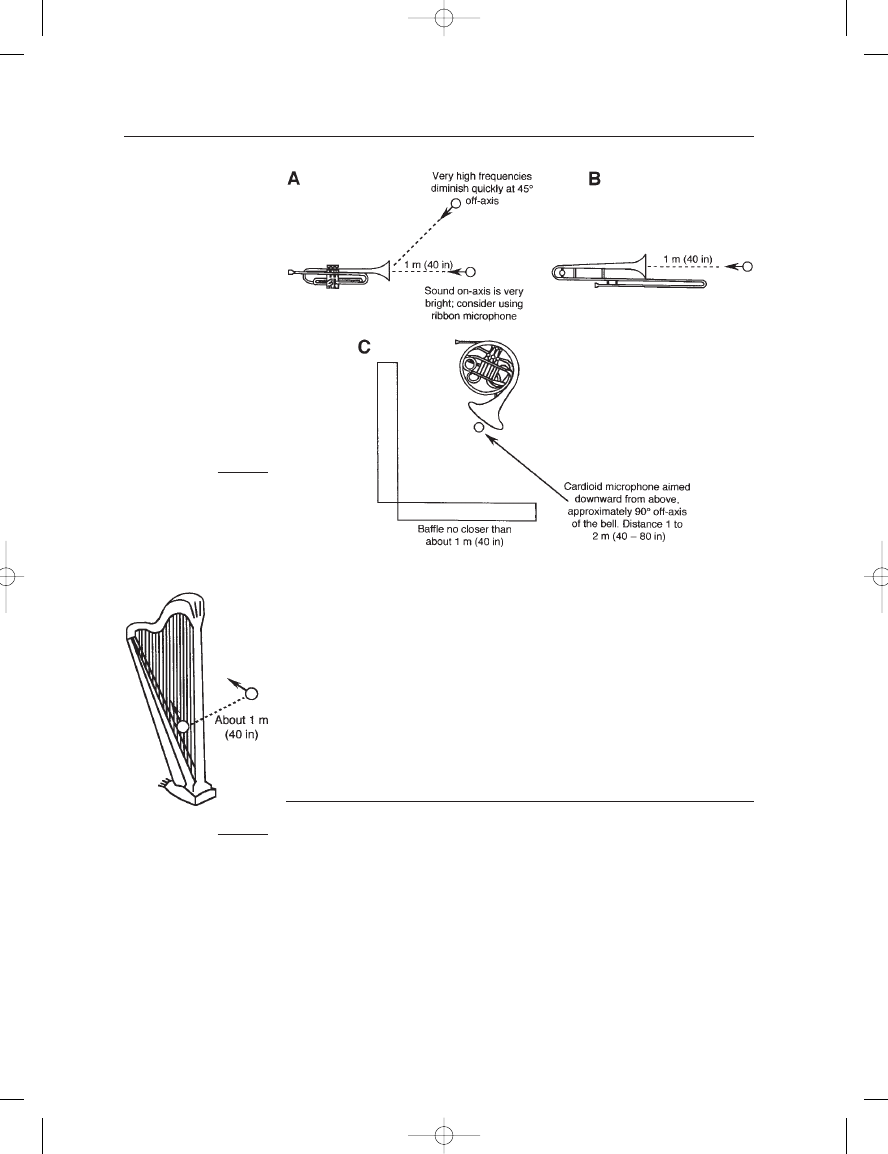
balance at close operating distances. Nevertheless, clip-on microphones
are often used on-stage when string instruments are used in combination
with much louder instruments. Since the bowed instruments are normally
used in multiples, we will discuss their pickup below under The Large
Studio Orchestra.
The harp can be recorded as shown in Figure 14–20. A spaced stereo
pair of omnidirectional microphones will produce the best timbre, but
in a crowded studio it may be mandatory to use cardioids for added
isolation.
ENSEMBLES IN THE STUDIO
Our discussion here will be limited to three jazz ensembles ranging from
small to large and a single large studio orchestra, such as might be used
for film scoring.
A JAZZ TRIO
Basic layout and panning
Figure 14–21A shows the studio layout for a basic jazz instrumental trio
consisting of piano, drums and bass. The simplicity of this ensemble
allows us to explore the basic advantages of stereo recording of both the
piano and drum set.
14: Studio Recording Techniques
233
FIGURE 14–19
Recording brass
instruments: trumpet (A);
trombone (B); French
horn (C).
FIGURE 14–20
Recording the harp in
stereo.
Earg_14.qxd 14/9/04 2:55 PM Page 233
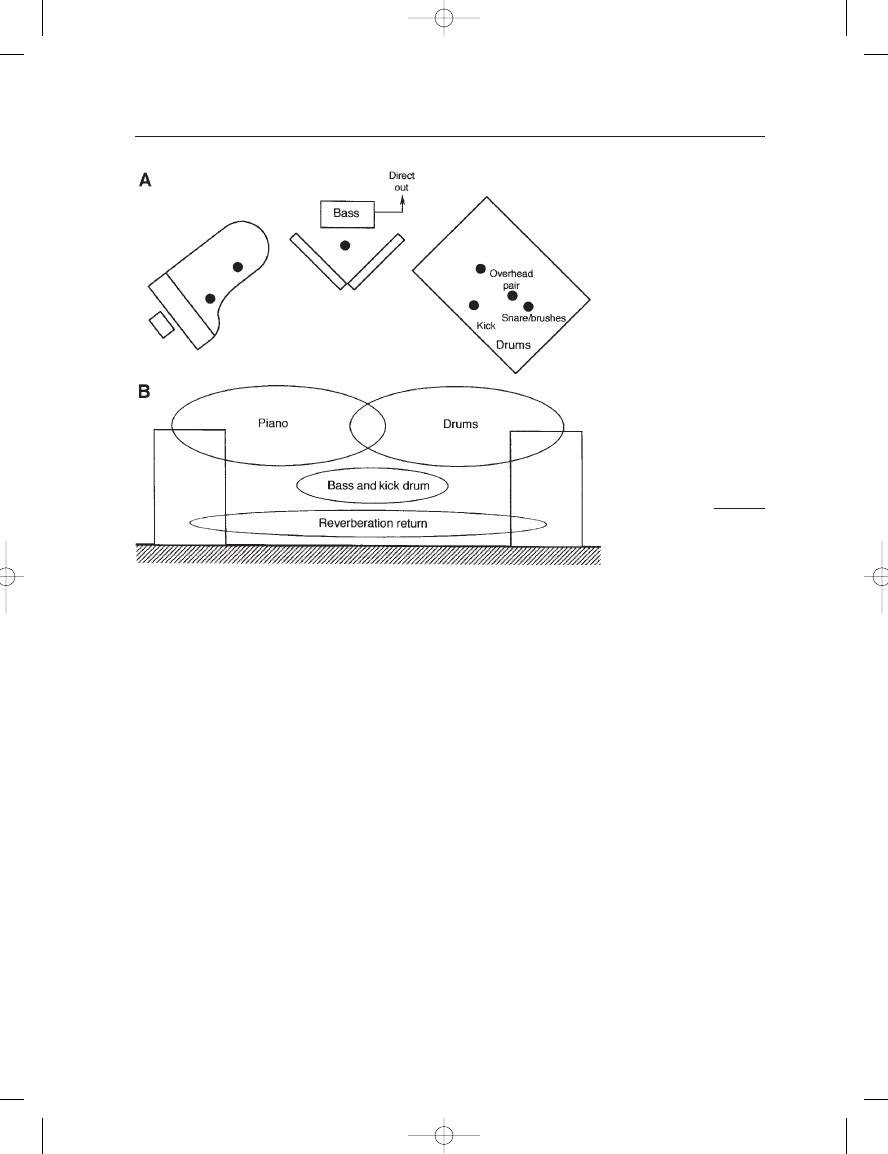
Whenever possible, the engineer and producer should place the
musicians in the studio with the same left-to-right positioning as
intended in the final postproduction mix. The reason here is that any
studio leakage will be between adjacent instruments as they appear on
the stereo soundstage and thus not create any conflicting spatial cues.
Studio leakage is not necessarily a bad thing, and it can vitally enhance
a performance rich in acoustical cues when the instruments are so tightly
clustered together.
The piano has been placed at the left, since the open cover of the
instrument will reflect sound to both the bassist and drummer. The
bassist is placed in the center with both microphone and direct pickup.
The drum set is placed at the right and uses an overhead stereo pair with
additional microphones on both the snare and kick drums. The primary
purpose of the snare microphone is to pick up the delicate playing of
brushes on the snare drum.
Establishing the monitor mix
Both producer and engineer must be in mutual agreement on the stereo
layout of the recording. Here, the aim is to have the piano be reproduced
from the left half of the stereo stage, and this calls for panning the treble
piano microphone at the left and the bass piano microphone at the cen-
ter. Because of the considerable leakage between the signals at both
THE MICROPHONE BOOK
234
FIGURE 14–21
Recording a jazz trio:
studio layout (A); target
stereo soundstage (B).
Earg_14.qxd 14/9/04 2:55 PM Page 234
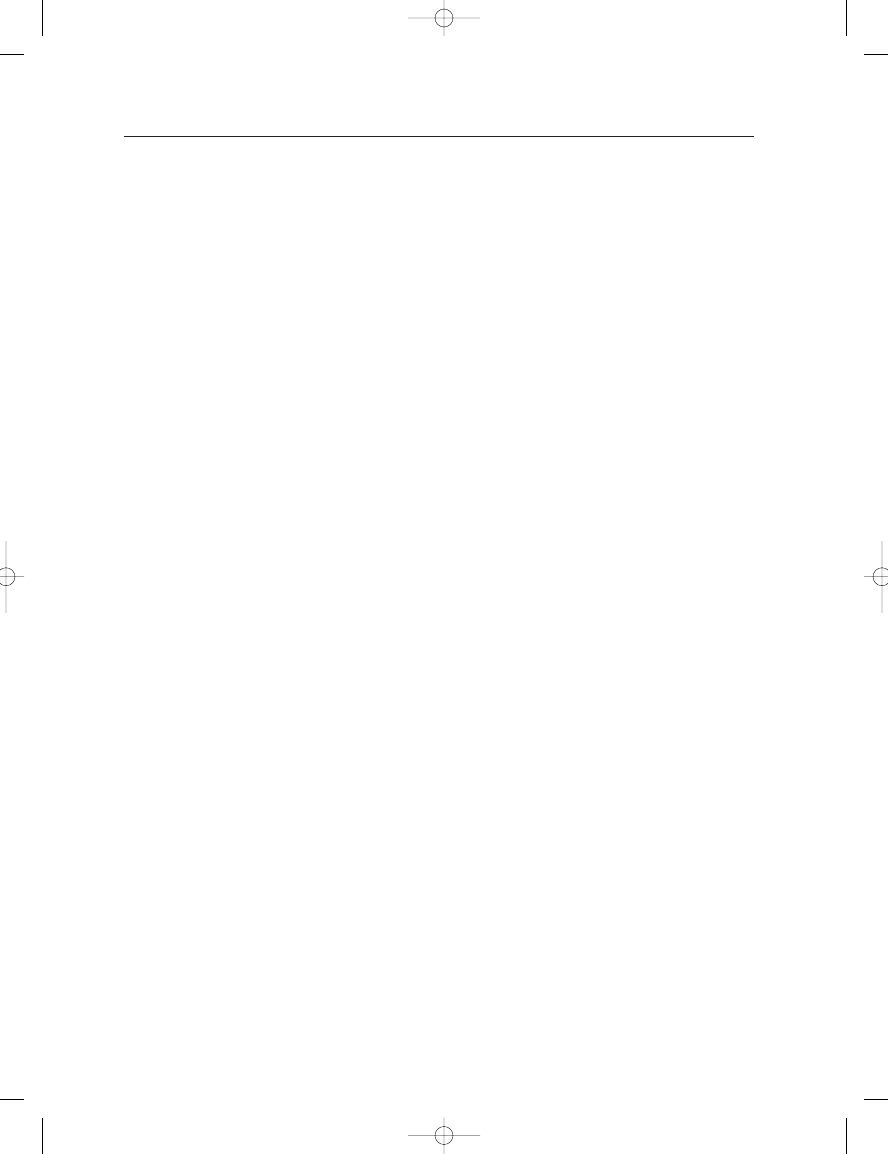
microphones the sound will appear from the left half of the stereo stage,
with high frequencies tending toward the left and middle and low fre-
quencies tending toward the center.
The bass microphone and direct pickup will both be panned to the
center in whatever proportion best fits the music. The balance between
the two can in fact vary throughout the recording from tune to tune.
The kick drum microphone will be panned to the center, and the
drum overheads will be panned center and right. The microphone on the
snare will be subtly mixed in and panned between center and right.
In a typical studio environment, the piano and bass inputs will be fed
to the stereo inputs of an external reverberation generator whose stereo
returns will be panned to the left and right signal buses. The choice of
whether to use any artificial reverberation on the drum microphones is
open for consideration. Normally none is used.
The reverberation parameters for this recording would normally be
set for a LF (below 500 Hz) reverberation time of about 1 second, with
reverberation time above that frequency slightly longer.
The target stereo soundstage
The representation at Figure 14–21B gives a picture of the resulting
soundstage as intended by the producer and engineer. Note that the
stereo presentation is wide, yet preserves good center-stage imaging of
the bass as well as portions of the piano and drum set. The reverberation
return signals should be panned full left and right in order to simulate
the widest spatial separation. For a group as small as this, and with
instruments that are equally balanced acoustically, there may be virtually
no need for headphone monitoring.
JAZZ VOCAL WITH SMALL INSTRUMENTAL GROUP
Basic layout and panning
Figure 14–22A shows the basic studio setup and panning assignments for
a jazz group consisting of vocalist, two solo saxophones and a full
rhythm section. As before, the studio left-to-right setup is in keeping
with the anticipated sound stage.
The piano has been replaced by a Hammond electronic organ, a
mainstay in blues-type jazz vocals. The organ is recorded in stereo with
microphones next to its HF and LF loudspeakers. The Hammond B-3
model is never recorded direct-in because of the extensive pre-processing
of the signal and the fact that it normally uses the Leslie loudspeaker sys-
tem, with its characteristic HF rotating loudspeaker array. The acousti-
cal guitar is picked up with both microphone and direct output. Both
organ and guitar are arrayed in stereo, respectively on the left and right,
enhancing the musical dialog that often takes place between them.
The two saxophones are placed left and right. When they are play-
ing in counterpoint or dialog, their left and right panned positions are
14: Studio Recording Techniques
235
Earg_14.qxd 14/9/04 2:55 PM Page 235
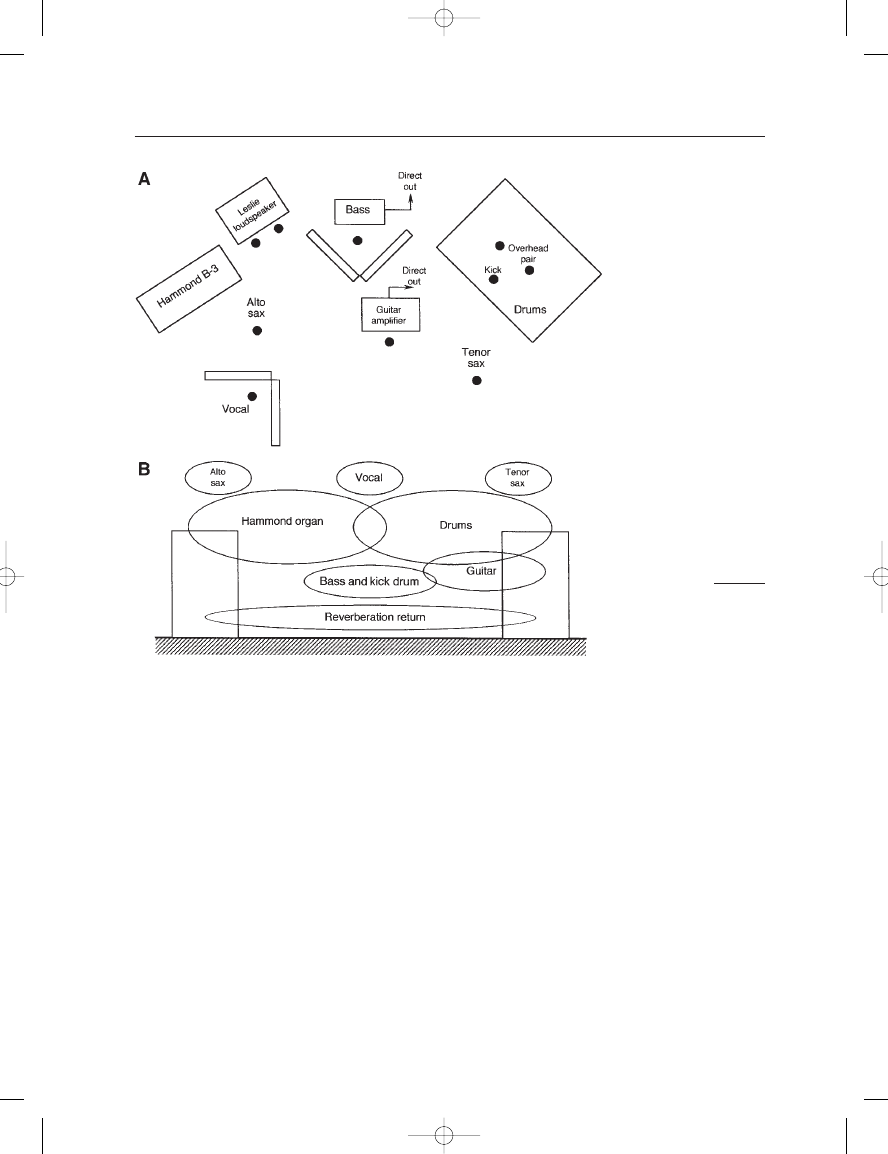
maintained; when either instrument is playing a solo chorus it may be
panned to the center of the stereo stage. The reason here is purely tradi-
tion and expectation. Bass and drums are positioned as in the previous
example.
Establishing the monitor mix
The first step is to establish a basic balance with bass, drums and organ;
listen for a smooth but detailed soundstage from left to right. Then the
guitar can be introduced into the mix. As a final step, balances among
the vocalist and saxophone soloists are made. Reverberation sends
should be taken from all instruments, except possibly the drums, and
returned to the monitor mix with full left and right panning.
The target stereo soundstage
The representation in Figure 14–22B shows the stereo soundstage as
intended by the producer and engineer. There are three basic spatial
layers in the recording: front-most are the three essential soloists. The
THE MICROPHONE BOOK
236
FIGURE 14–22
Recording jazz vocal with
small instrumental group:
studio setup (A); target
stereo soundstage (B).
Earg_14.qxd 14/9/04 2:55 PM Page 236
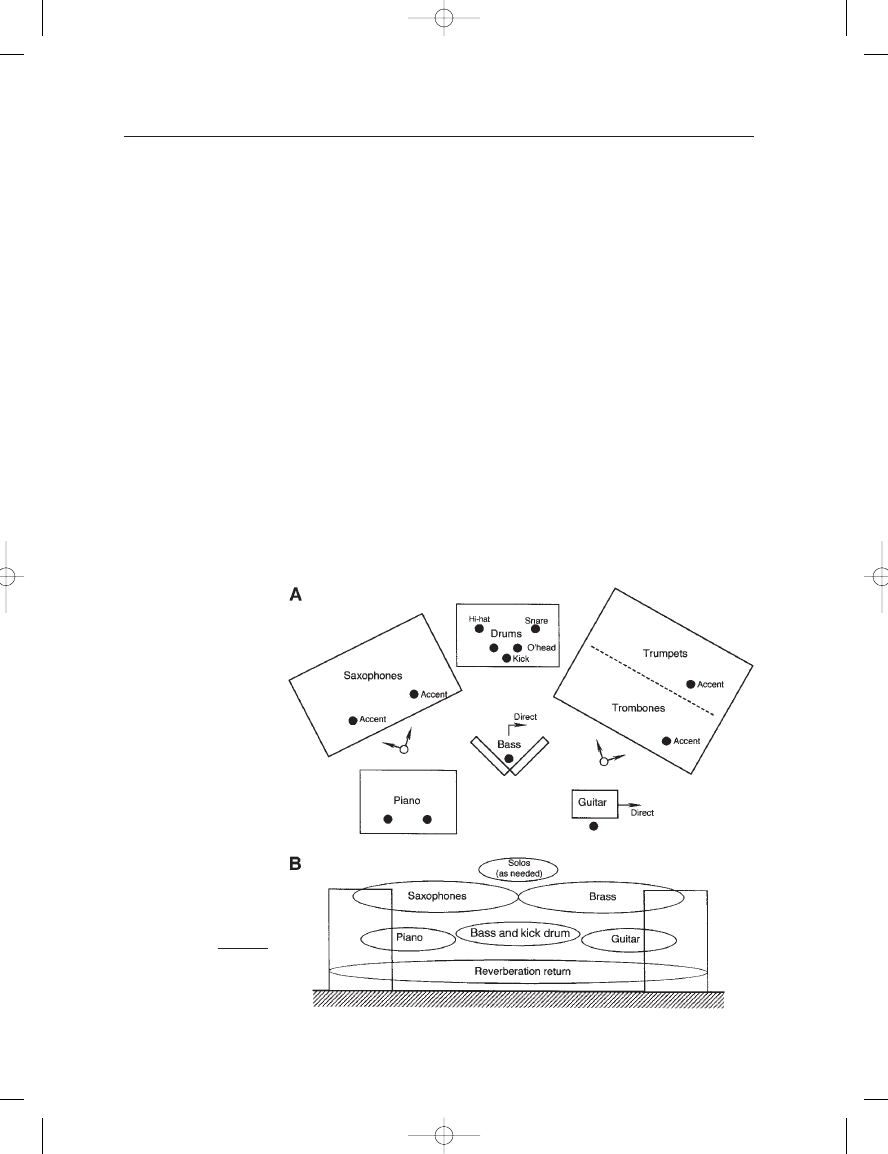
secondary layer includes the rhythm elements, and the reverberation
return constitutes the back layer.
At times, the rhythm elements will take on primary importance, and
when the do they should be boosted in level according to their impor-
tance. A basic skill of any recording engineer is knowing when – and
how much – to alter the level of an instrument that moves from one layer
to another. An experienced producer is of great help here.
Always bear in mind that not all elements in the mix can have equal
importance at the same time. Both spatial and frequency dimensions must
be considered; whenever possible, important elements in the mix should
be perceived as coming from separate directions. Likewise, the mix, as
perceived overall, should exhibit a uniform spectrum from top to bottom.
JAZZ BIG BAND
Basic layout and panning
The standard large jazz band normally consists of four trombones, four
trumpets, and five saxophones in the brass and wind departments.
Rhythm elements consist of drums, bass, piano and guitar. Brass and
wind players may also double, respectively, on French horn, clarinet or
flute. There may be an additional percussion player as well. Figure 14–23A
shows a typical studio layout. The trumpets are usually placed on a riser
14: Studio Recording Techniques
237
FIGURE 14–23
Recording a jazz big band:
studio layout (A); target
stereo soundstage (B).
Earg_14.qxd 14/9/04 2:55 PM Page 237